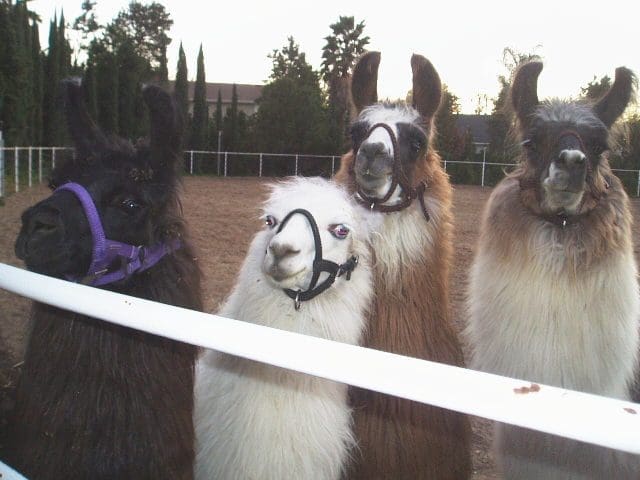If you have been smitten by a llama, you may be fantasizing about owning one.
In fact every single week, Mama Llama encounters someone who desires to own a llama. Those woolly, friendly, funny llamas are irresistible. But should you own one?

Well, you can’t just own ONE. Llamas live in social groupings called packs. A llama all by himself would pine away and die! So you would have to buy…not one more llama but TWO MORE! A pack of three is the minimum number for the animals to feel safe. That’s a small pack. A medium pack totals five llamas, and a large pack has six llamas. After that, you’ve got multiple packs, which equals a herd, and they usually have separately fenced living quarters according to their age and temperament. Additionally, males do not live in the same enclosure with females after they are weaned.

Within a pack, one llama is the leader, and the rest jockey for their position based on winning or losing wrestling matches and other llama activities. When danger lurks, llamas in a pack rush together and stand strong against a predator. A pack is a family unit, and llamas do well in groups of three to six.
It is true that a single llama or two females that possess a guardian’s temperament can be used to protect small livestock, specifically alpacas, goats and sheep. Llamas will defend these critters with their lives. But llamas thrive within their own species. And there are other animals well-suited as guardians of small livestock, especially Anatolian Shepherds, Great Pyrenees and donkeys.
Llamas must exercise daily and they need room to run. About an acre is a good starting size for a small or medium pack. But first check with your city hall for zoning laws relating to “head per acre.” In some cities, four llamas can live on a single acre, while in other cities, four llamas must be allotted four acres!

Llamas must live on land that is zoned for horses or livestock, even if the land is big enough for a small or large pack of llamas.
Very few veterinarians are trained to come to the aid of a sick llama. Llamas are remarkably hardy animals, but you may be hard-pressed to find qualified emergency medical care. Why? Llamas have not been studied long in the U.S., and most veterinary schools don’t teach about them.
There are more than 125 common plants that are poisonous to llamas. Clear identification and cross referencing of every single plant and weed must be made before bringing llamas onto your property. That’s why llamas live on dirt-lot properties or within fenced grassy fields, usually far enough away from neighbors that leaves don’t blow into the llamas’ field. In the spring, diligence is required to remove plants that grow seemingly overnight after birds, rabbits, squirrels and other critters move from yard to yard.
Llamas can easily pick up the parasites of other barnyard zoo animals. At most farms, critters share land, and there’s little harm if one species eats the food of another species. Not so with llamas housed with chickens, goats and sheep, which eat feed and supplements that are not good for llamas. Parasites are also a problem for llamas that can easily pick them up from other farm animals. Whitetail deer, especially, must not pass through the llamas’ enclosure. Instead of living with other species, it’s best that llamas live next to the rest of the barnyard animals on the other side of a fence.
Llamas are sensitive to heat and humidity. They grow wool–about six pounds each–which must be removed just before summer and again mid-summer in southern states. Even without their coats on, they need fans pointed low at their digestive system, where they get the hottest. Shelter is necessary year-round to protect these animals from the overhead sun and rain, and to keep their feet and bellies warm and dry in the winter.
So, should you own llamas? Yes, they will enhance your life and be on track to live long, healthy lives themselves if…you have properly zoned, cleared and fenced land plus a great veterinarian with experience caring for this relatively unusual pet, and a temperature-controlled shelter. Whew!
But if that’s not your situation, you can still visit llamas at local zoos, animal adventure parks, wildlife attractions, plus some private zoos like ShangriLlama! And if you’d like to learn about llamas, do come for a Llama Llesson during the summer in the llamas’ air-conditioned barn.
Happy Trails from the llama-smitten Mama Llama!
